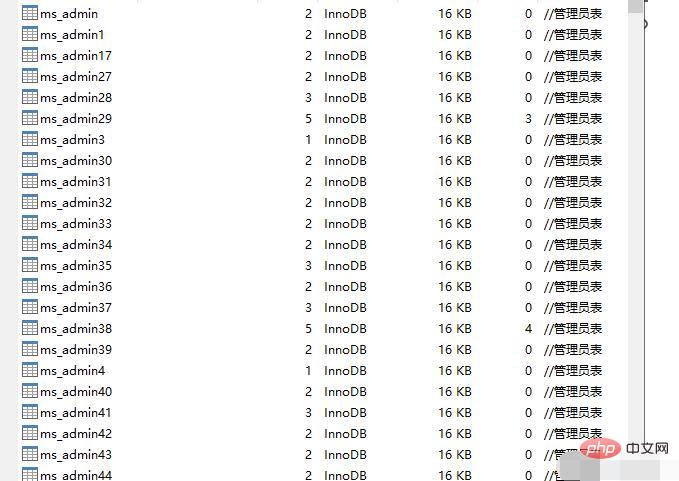How to implement saas using php
Saas implementation method using PHP: 1. Create a separate backend and allocate an account; 2. Transform the database operation method of TP into a public method; 3. Use session to store "saas_id" in the backend, and Query using a fixed method; 4. Encapsulate the request method and add "saas_id" fixedly.

The operating environment of this tutorial: windows7 system, PHP8.1 version, DELL G3 computer
How to implement saas with php?
About PHP implementing saas function through sub-tables
Let me briefly talk about my understanding of saas. saas is equivalent to treating your own project as a The platform allows sub-users to use platform functions by dividing accounts.
Home page The first way I tried was to distinguish each table by adding a saas_id. Currently, the amount of data in each of my tables is about 60,000. , if 10 additional users are used, the number will be 600,000. Whether it is viewing or changing the efficiency, it will definitely not be particularly high, because after the amount of background data increases, it is also considered to divide the tables by year, so give up this method. The next thing I think about is Sub-database, because it is most appropriate to sub-database according to different sub-users in Anzhao according to the year. However, due to various reasons, this method was not used, and the sub-table was used in the end. Because the function of this project has been developed, what is needed now is probably these steps
The first step is to write a function to open an account. Here you can write a separate backend to allocate account opening, or write a Small programs such as h5 allow users to apply for it by themselves. The following is my method of dividing tables to generate a database.
$exist = Db::query('show tables like "ms_user' . $id . '"');
if (!$exist) {
方法1: $sql = <<<sql
CREATE TABLE ms_user{$id} LIKE ms_user;
sql;
Db::execute($sql);
方法二: $sql = <<<sql
CREATE TABLE ms_apply{$id} LIKE ms_apply;
sql;
Db::execute($sql);
$sql = <<<sql
INSERT ms_apply{$id} SELECT * FROM ms_apply;
sql;
Db::execute($sql);
die;
}
}The general principle is to first check whether the saas_id has a generated data table, just in case. ! If the content does not need to be copied to a new table, just copy the table structure directly according to method 1. For example, if some public tables need to copy the public content to a new table, you need to add the data to the new package according to the second step of method 2.
The following is the table structure after splitting:

The second step is to transform the database operation method of tp into a public method to facilitate replacement. The code looks like a loser, but it actually saves a lot of effort
//db类
function dbs($table=''){
$table=$table.session('user.saas_id');
return Db::name($table);
}
function dba($table=''){
$table=$table.input('param.saas_id');
return Db::name($table);
}The backend uses the session to store the saas_id query and uses a fixed method to query, and the frontend encapsulates the request method and fixes the saas_id
field request. If you want to use the model to query the database and do not use the Db class, you can contact me.
…I’ll update here first, and I’ll update later. If you don’t understand, you can message me privately!
Recommended learning: "PHP Video Tutorial"
The above is the detailed content of How to implement saas using php. For more information, please follow other related articles on the PHP Chinese website!

Hot AI Tools

Undresser.AI Undress
AI-powered app for creating realistic nude photos

AI Clothes Remover
Online AI tool for removing clothes from photos.

Undress AI Tool
Undress images for free

Clothoff.io
AI clothes remover

Video Face Swap
Swap faces in any video effortlessly with our completely free AI face swap tool!

Hot Article

Hot Tools

Notepad++7.3.1
Easy-to-use and free code editor

SublimeText3 Chinese version
Chinese version, very easy to use

Zend Studio 13.0.1
Powerful PHP integrated development environment

Dreamweaver CS6
Visual web development tools

SublimeText3 Mac version
God-level code editing software (SublimeText3)

Hot Topics
 1386
1386
 52
52
 PHP 8.4 Installation and Upgrade guide for Ubuntu and Debian
Dec 24, 2024 pm 04:42 PM
PHP 8.4 Installation and Upgrade guide for Ubuntu and Debian
Dec 24, 2024 pm 04:42 PM
PHP 8.4 brings several new features, security improvements, and performance improvements with healthy amounts of feature deprecations and removals. This guide explains how to install PHP 8.4 or upgrade to PHP 8.4 on Ubuntu, Debian, or their derivati
 How To Set Up Visual Studio Code (VS Code) for PHP Development
Dec 20, 2024 am 11:31 AM
How To Set Up Visual Studio Code (VS Code) for PHP Development
Dec 20, 2024 am 11:31 AM
Visual Studio Code, also known as VS Code, is a free source code editor — or integrated development environment (IDE) — available for all major operating systems. With a large collection of extensions for many programming languages, VS Code can be c
 7 PHP Functions I Regret I Didn't Know Before
Nov 13, 2024 am 09:42 AM
7 PHP Functions I Regret I Didn't Know Before
Nov 13, 2024 am 09:42 AM
If you are an experienced PHP developer, you might have the feeling that you’ve been there and done that already.You have developed a significant number of applications, debugged millions of lines of code, and tweaked a bunch of scripts to achieve op
 How do you parse and process HTML/XML in PHP?
Feb 07, 2025 am 11:57 AM
How do you parse and process HTML/XML in PHP?
Feb 07, 2025 am 11:57 AM
This tutorial demonstrates how to efficiently process XML documents using PHP. XML (eXtensible Markup Language) is a versatile text-based markup language designed for both human readability and machine parsing. It's commonly used for data storage an
 Explain JSON Web Tokens (JWT) and their use case in PHP APIs.
Apr 05, 2025 am 12:04 AM
Explain JSON Web Tokens (JWT) and their use case in PHP APIs.
Apr 05, 2025 am 12:04 AM
JWT is an open standard based on JSON, used to securely transmit information between parties, mainly for identity authentication and information exchange. 1. JWT consists of three parts: Header, Payload and Signature. 2. The working principle of JWT includes three steps: generating JWT, verifying JWT and parsing Payload. 3. When using JWT for authentication in PHP, JWT can be generated and verified, and user role and permission information can be included in advanced usage. 4. Common errors include signature verification failure, token expiration, and payload oversized. Debugging skills include using debugging tools and logging. 5. Performance optimization and best practices include using appropriate signature algorithms, setting validity periods reasonably,
 PHP Program to Count Vowels in a String
Feb 07, 2025 pm 12:12 PM
PHP Program to Count Vowels in a String
Feb 07, 2025 pm 12:12 PM
A string is a sequence of characters, including letters, numbers, and symbols. This tutorial will learn how to calculate the number of vowels in a given string in PHP using different methods. The vowels in English are a, e, i, o, u, and they can be uppercase or lowercase. What is a vowel? Vowels are alphabetic characters that represent a specific pronunciation. There are five vowels in English, including uppercase and lowercase: a, e, i, o, u Example 1 Input: String = "Tutorialspoint" Output: 6 explain The vowels in the string "Tutorialspoint" are u, o, i, a, o, i. There are 6 yuan in total
 Explain late static binding in PHP (static::).
Apr 03, 2025 am 12:04 AM
Explain late static binding in PHP (static::).
Apr 03, 2025 am 12:04 AM
Static binding (static::) implements late static binding (LSB) in PHP, allowing calling classes to be referenced in static contexts rather than defining classes. 1) The parsing process is performed at runtime, 2) Look up the call class in the inheritance relationship, 3) It may bring performance overhead.
 What are PHP magic methods (__construct, __destruct, __call, __get, __set, etc.) and provide use cases?
Apr 03, 2025 am 12:03 AM
What are PHP magic methods (__construct, __destruct, __call, __get, __set, etc.) and provide use cases?
Apr 03, 2025 am 12:03 AM
What are the magic methods of PHP? PHP's magic methods include: 1.\_\_construct, used to initialize objects; 2.\_\_destruct, used to clean up resources; 3.\_\_call, handle non-existent method calls; 4.\_\_get, implement dynamic attribute access; 5.\_\_set, implement dynamic attribute settings. These methods are automatically called in certain situations, improving code flexibility and efficiency.




